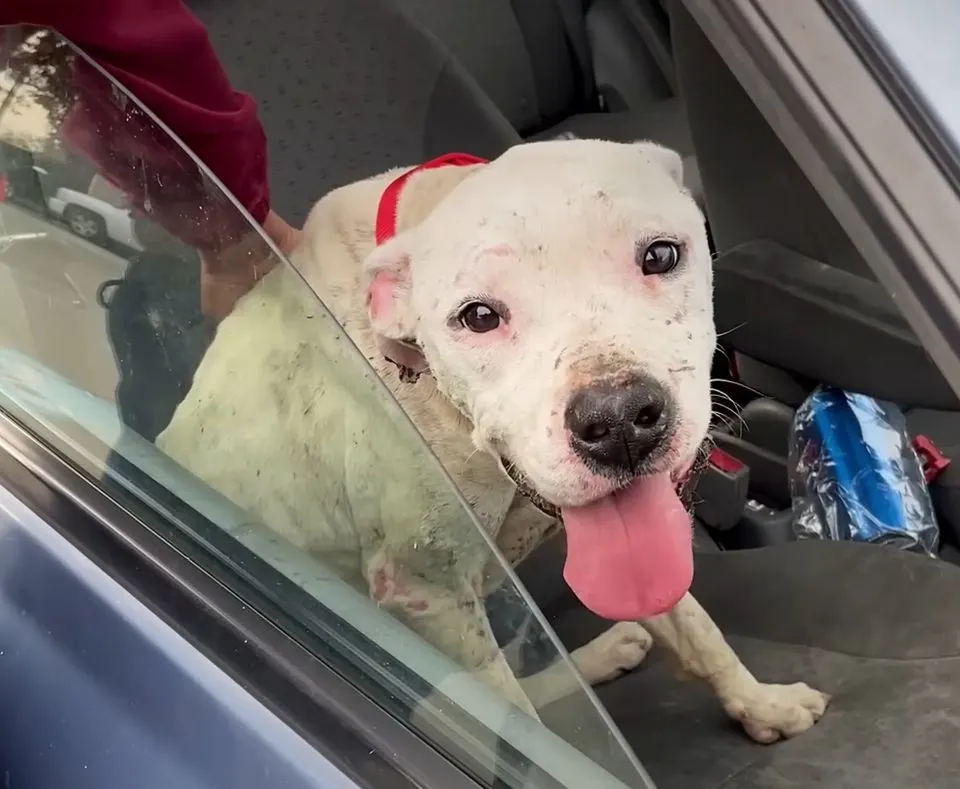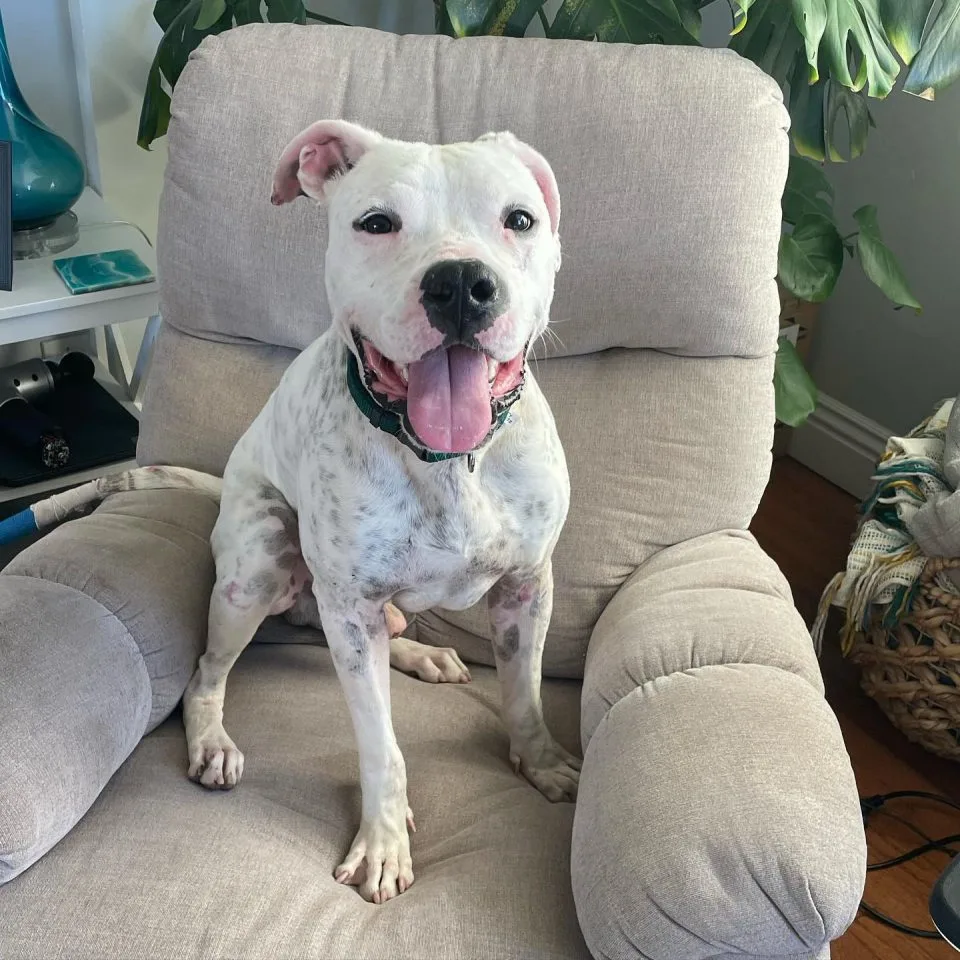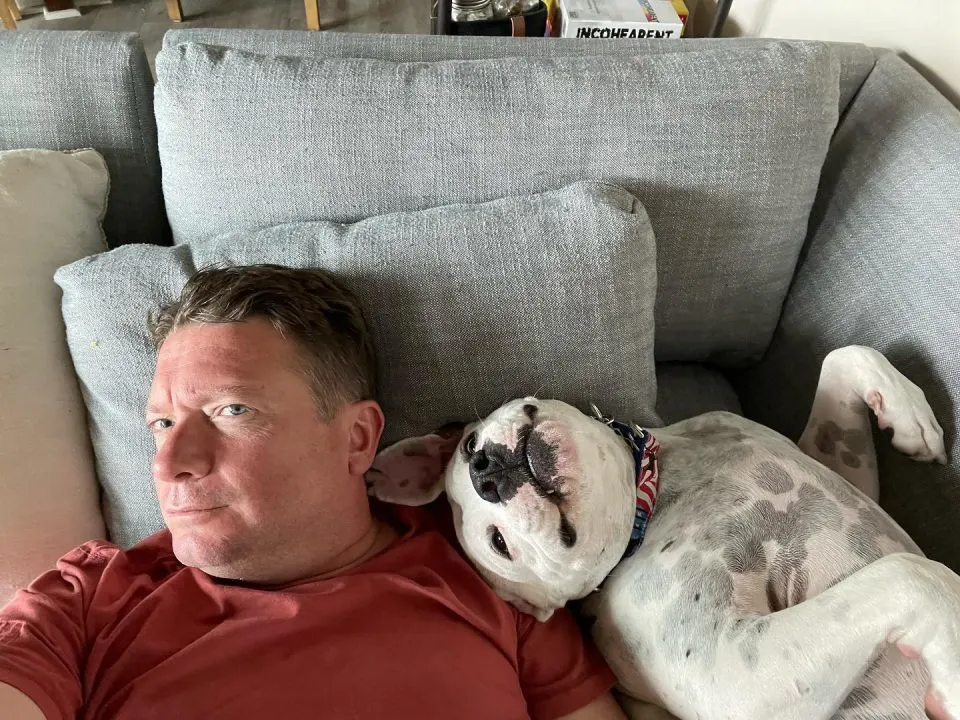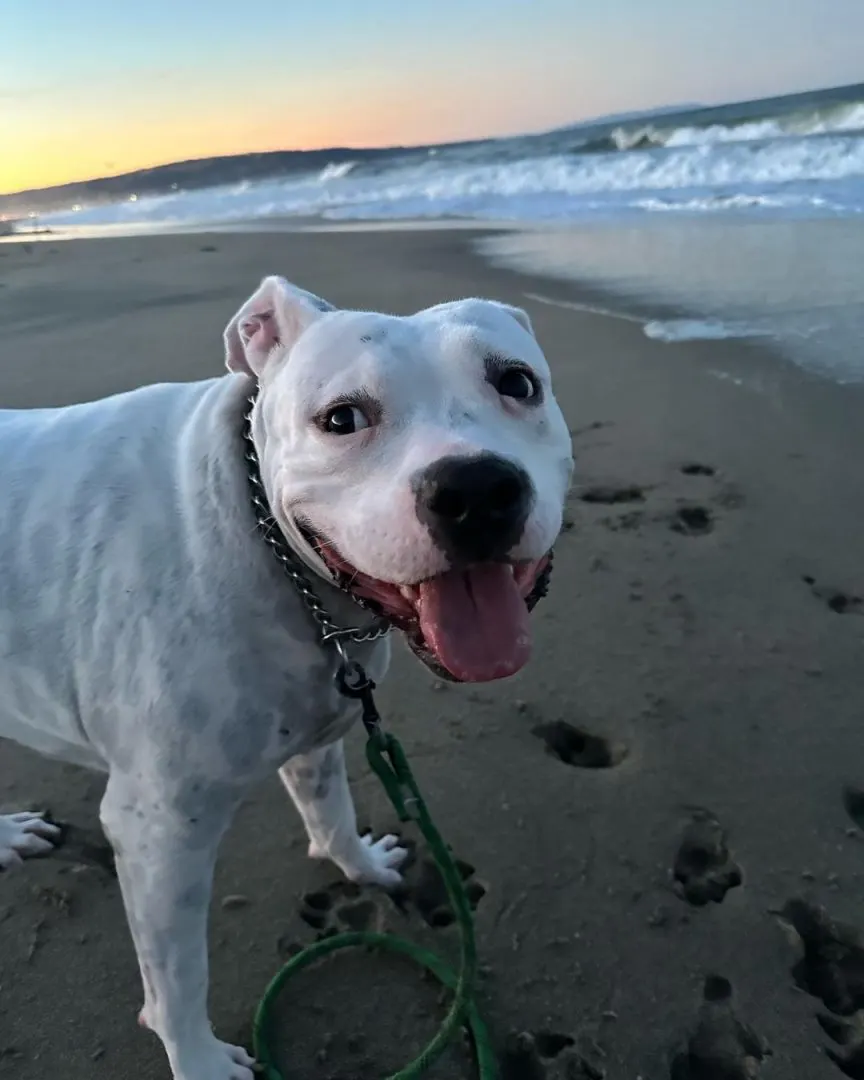It’s stories like Charlie’s that restore our faith in humanity!
This amazing Pittie was cruelly abandoned by his family. For many days and nights, he roamed the streets of Compton in hope of finding a refuge for himself.
Weak, emaciated, and covered in bloody wounds, this poor boi would definitely not have made it on his own. Given his condition, he was literally days away from the point of no return.
A giant-hearted woman spotted him on the street and dropped him off at a local shelter in the attempt to give him a temporary home, but then, something amazing happened!
Saved At The Last Minute

Shira Scott Astrof, the founder of The Animal Rescue Mission, was on her way to the Downey shelter to pick up a dog when she saw Charlie. The woman who found him on the street drove him all the way to the shelter, but this weak Pittie needed vet help.
One of the workers asked Shira, the long-time dog rescuer, to take in Charlie, as he would have definitely not made it in the shelter.
“I arrived at the Downey shelter to pick up a senior girl when I saw an emaciated, scared puppy covered in deep wounds being dropped off. One of the shelter workers said to me: Please don’t let this dog enter the shelter, he won’t make it out,” Shira wrote.

With the help of her friend, Katie Cleary, of Peace 4 Animals, Shira managed to take Charlie to Malibu hospital and give him much-needed treatment.
Despite his condition and the fact that his wounds were probably the result of him being used as a baiting dog, he never, ever displayed aggression.
He was such a lovely, gentle Pittie who wagged his tail all along, as if he was trying to say: “Thank you for saving me, hoomans!”
“These dogs are incredible. Even after the horrific torture he had endured at the hands of humans, all he wants to do is love and be loved,” Shira wrote on her Instagram.
From Abandonment To A Loving Home

Charlie stayed at the vet for several weeks until he finally felt better. He was given care around the clock, and in just a few short days, he had already gained weight and started eating properly.
The good news was – he didn’t need to wait long for his forever home! One of Shira’s friends told her about a man named Jay, who fell in love with Charlie’s story and would be really happy to give him a forever home.
After Charlie got out of the hospital, he and Jay finally met – and melted everyone’s hearts! Even though it was their first meeting ever, the two bonded immediately, proving that they’re gonna be the best buds in the world!

Jay took Charlie to his home in Manhattan Beach, California. This amazing duo embarked on a wonderful journey together, and it seems that Charlie loves every second of it.
He acclimated to the new home as if he had always been Jay’s dog. He meets new people on a daily basis, goes for beautiful beach walks, and he even swims in the ocean with his dad!

Charlie has finally got the perfect place to exhibit his true personality, and Jay’s just grateful for being able to provide him a safe place. After everything he has been through, seeing him run happily again is the greatest privilege.
We hope that Jay and Charlie will enjoy each other’s company for many more years. Given their amazing bond, there’s absolutely no doubt that they will make every new day count!
You can keep up with Charlie and his dad on their official Instagram.
Have you ever noticed your furry friend plopping down right on your feet, claiming them as their favorite spot? It’s a common behavior among dogs that can leave you wondering about the reasons behind this endearing yet sometimes puzzling habit. As a seasoned dog trainer, I’ve witnessed this behavior countless times and can shed some light on why your canine companion might choose to cozy up on your toes.
When your dog settles on your feet, it’s not just about seeking warmth or comfort. Dogs have a unique way of showing affection and seeking security, and sitting on your feet can be their way of bonding with you and feeling protected. Understanding the underlying motivations behind this behavior can deepen the special connection you share with your loyal four-legged friend. So, next time you feel those warm paws on your feet, remember, it’s more than just a comfy spot – it’s a heartwarming display of love and trust from your beloved pet.
Understanding Canine Behavior
The Psychology Behind Dogs Sitting on Feet
When your dog sits on your feet, it’s not just to keep warm – it’s a bonding behavior. Dogs have a natural instinct to be close to their pack, and in a domestic setting, you are their pack. By sitting on your feet, your dog is showing trust, love, and a desire to be close to you. It’s a way for your furry friend to feel secure and connected to you.
Pack Mentality and Seeking Comfort
Dogs are pack animals by nature, and sitting on your feet is a way for them to seek comfort and security. Just like how puppies huddle together for warmth and protection in a litter, your dog sees you as their protector and provider of comfort. By sitting on your feet, your dog is seeking closeness and reassurance, much like they would in a pack environment.
Signs of Affection and Bonding
Expressing Love and Trust
When your dog sits on your feet, it’s their way of showing love and trust. Dogs are pack animals by nature, and sitting close to their pack members, including you, is a way of creating a bond. By choosing to sit on your feet, your dog is expressing their affection and reinforcing the connection they feel with you.
Seeking Attention and Interaction
Another reason your dog may sit on your feet is to seek attention and interaction from you. Dogs are social creatures and enjoy being close to their loved ones. Sitting on your feet allows them to be near you, feel your presence, and engage with you. It’s a way for them to communicate their desire for your attention and companionship.
Asserting Dominance or Seeking Protection
The Dominance Debate in Dog Behavior
In dog behavior, sitting on your feet can sometimes be linked to asserting dominance. Your dog might do this to show they are in charge or to claim territory. It’s a way for them to communicate hierarchy within your pack, with them trying to establish their position. So, if your dog is sitting on your feet, they could be subtly telling you, “I’m taking the lead here.”
Protective Instincts and Safety
When your dog sits on your feet, it could also be a sign of their protective instincts kicking in. Just like how a mother dog protects her puppies, your dog might feel the need to guard you. By sitting on your feet, they are positioning themselves to watch over you and keep you safe. It’s their way of saying, “I’ve got your back,” showing their loyalty and dedication to keeping you out of harm’s way.
Communicating Needs or Discomfort
Soliciting Care or Assistance
Dogs sitting on your feet might be signaling that they need help or support. This behavior can indicate a desire to be close to you for protection or reassurance during stressful situations. By sitting on your feet, your furry friend seeks comfort and security, showing trust in your presence to provide a sense of safety and well-being.
Managing Anxiety or Stress
When a dog chooses to sit on your feet, it could be a way of managing anxiety or stress. Dogs, like humans, can feel overwhelmed or anxious at times, and seeking physical contact with their owner helps them feel calmer and more secure. By sitting on your feet, your canine companion may be seeking comfort and a sense of security to alleviate their stress or anxiety, finding solace in your closeness and warmth.
Training and Encouraging Desired Behaviors
Positive Reinforcement Techniques
When your dog sits on your feet, it’s essential to reinforce positive behaviors. Use treats, praise, and affection when your dog sits elsewhere or behaves in ways you prefer. By rewarding desired behaviors, you’re encouraging your dog to repeat them.
Addressing Overly Clingy Behavior
If your dog’s constant need to sit on your feet becomes overwhelming or disrupts your daily routine, it’s crucial to address this behavior positively. Encourage independence by creating a comfortable space nearby with their bed or favorite toys. Gradually increase distance while providing reassurance and attention to help your dog feel secure even when not sitting on your feet.
Conclusion
Dogs sitting on your feet isn’t just about warmth or comfort; it’s a heartfelt display of trust, love, and a desire for closeness. This behavior stems from their pack instinct, where you’re seen as part of their family. By sitting on your feet, they seek reassurance, protection, and a strong bond with you. It’s their way of showing affection, seeking attention, and even asserting dominance or protective instincts. Remember, when your furry friend sits at your feet, it’s their unique way of communicating needs, managing anxiety, and finding comfort in your presence. Encourage positive behaviors and gradually promote independence while showering them with love and attention. Your bond will only grow stronger with each tail wag and paw on your feet.
Frequently Asked Questions
Why do dogs sit on their owner’s feet?
Dogs sitting on their owner’s feet is a behavior rooted in their instinct as pack animals. It signifies trust, love, and a desire for closeness. Similar to puppies seeking warmth in a huddle, it symbolizes seeking reassurance, comfort, and protection, as well as attention and interaction, strengthening the bond with their owner.
Is it a sign of dominance when a dog sits on their owner’s feet?
While it can be interpreted as asserting dominance or claiming territory, dogs sitting on their owner’s feet also reflects protective instincts. It indicates loyalty, dedication, and a desire to watch over and keep their owner safe, rather than solely dominance-related behavior.
How can I address my dog’s overly clingy behavior of sitting on my feet?
To positively address overly clingy behavior, encourage desired behaviors through positive reinforcement techniques. Use treats, praise, and affection when the dog sits elsewhere, gradually promoting independence by creating a comfortable space nearby with their bed or favorite toys, while providing reassurance and attention to manage anxiety and stress levels.
[no_toc]

Hey there, I’m Janet Brooks, a dog-loving student from California. I’m all about helping pups in need, especially those without homes. Me and my awesome friends work together to give shelter and love to stray dogs. Oh, and I also write blogs about dogs to share helpful info.